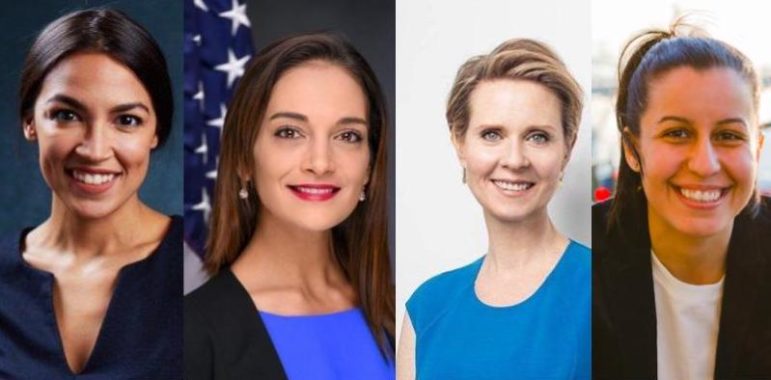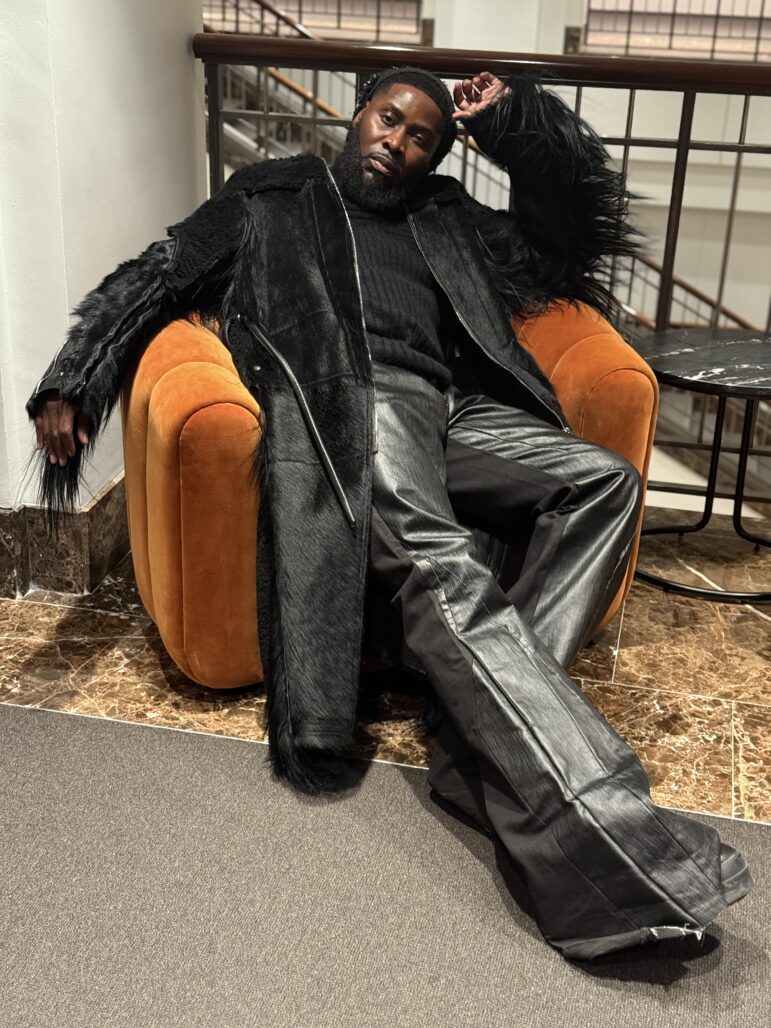
Office of Rep. Ocasio-Cortez, NY State Senate, Friends of Cynthia Nixon, Caban for DA
Four candidates whose campaigns over the 2018-2019 period helped forge an alliance between the WFP and the DSA: Alexandria Ocasio-Cortez, Julia Salazar, Cynthia Nixon and Tiffany Caban.
The Cabán-Katz race for Queens District Attorney is now finally a handful of days away from being decided. Cabán went from the outside lane at the start of the race to an apparent victory on June 25th. Her lead increased from 1,090 to 1,130 a couple of days later when the last machines were counted. But then it vanished when affidavit and absentee ballots were tallied. She was down 20 votes, and then 16, after her lawyers recovered six affidavit votes – one for Katz and five for Cabán. We now await the end of the manual recount.
But whatever the outcome, this race signals something significant for left-liberal politics in New York: the coming together of the Working Families Party and the Democratic Socialists of America.
The WFP brings 20 years of hard-won expertise and important relationships with organized labor. The DSA brings its own emerging expertise and, most importantly, thousands – literally, thousands – of mostly millennial activists.
This convergence was not a forgone conclusion, and as recently as 2017, it seemed much less likely.
The WFP was founded in 1998, but really put itself on the map in the early 2000s, first when it successfully primaried a Democratic “marginal,” Naomi Matusow, in 2002. Two years later, the party helped raise the state minimum wage and weaken the Rockefeller Drug laws, and four years after that, the WFP was central to Democrats taking control of the state Senate (briefly) for the first time since 1964. By 2008, the WFP was a rock of New York politics.
The Democratic Socialists of America are actually much older than the WFP, but have only recently become a key player in New York races. DSA formed in 1982, a merger of two organizations: the Democratic Socialist Organizing Committee, itself a splinter of the old Socialist Party, and the New American Movement, formed in the collapse of the Students for a Democratic Society in 1971. The likes of former New York City Mayor David Dinkins were members of DSOC-DSA, though no one attributed his mayoral victory to the organization – and rightly so.
But DSA transformed rapidly in 2015 and 2016, and by 2017 it was already a factor in local politics. The DSA grew rapidly as a result of two presidential campaigns: Bernie Sanders’ and Donald Trump’s. Bernie’s unsuccessful bid for the Democratic nomination in 2015-2016 sent thousands of people to the Internet to search “democratic socialism.” Many of them found their way to DSA. Then Trump’s victory over Hilary Clinton in the 2016 general election boosted the organization’s membership rolls even more. Today, there are some 5,000 DSA members in New York City and more than 60,000 nationally.
In late 2016, just weeks after Trump’s victory, NYC-DSA formed its electoral working group. In 2017, that working group steered thousands of new DSA members to a City Council race in Bay Ridge: Khader El-Yateem’s bid for the Democratic nomination. El-Yateem joined DSA, called himself a democratic socialist and DSA then joined the fight. The Working Families Party, however, was already in the race, backing Justin Brannan. Many of the party’s labor affiliates were also supporting the more mainstream candidate.
The race did two things at the same time: it showed the enduring power of the WFP and the labor movement, with Brannan registering an unequivocal win. However, El-Yateem racked up 2,932 votes, far more than anyone expected. Some of those votes were attributable to El-Yateem’s community coalition, but many were attributable to DSA and its thousands of members. Even in defeat, the race put DSA on the map.
As soon as the El-Yateem-Brannan matchup concluded, DSA pivoted to an independent Council race in central Brooklyn. The organization backed Jabari Brisport, running on the Green Party line, but also petitioned for its own socialist ballot line. Brisport lost handily, but he also earned more independent votes than any candidate since the WFP ran Letitia James on its own ballot line – and not the Democrats’ – in her successful 2003 run for Council.
DSA and the WFP struggled to come together in 2018. Groups like NO IDC formed in the grassroots and began to link members of the Independent Democratic Conference – responsible for keeping the New York State Senate in Republican control since the 2012 elections – to Trump. Primary challengers rapidly emerged. The WFP assessed the terrain and made a decision: they would work in IDC primary races, but leave the rest of the Democratic conference alone. They also, of course, challenged Gov. Cuomo, backing Cynthia Nixon in her bid for the Democratic nomination.
DSA took a quite different approach to the electoral cycle. It focused its energy on a primary challenge to State Senator Martin Dilan in North Brooklyn, a mainstream Democrat who had never joined the IDC. But the logic for DSA was not about the IDC: In the race against Dilan, they were able and ready to put forward one of their own, Julia Salazar, and have a real shot at winning. Initially, the WFP declined to support Salazar, keeping their focus on the governor and the IDC. DSA, for their part, declined to endorse any of the IDC challengers.
Then came Alexandria Ocasio-Cortez. Though she was recruited to run by Justice Democrats, she also joined DSA and sought the organization’s endorsement. She earned it, and members in Queens and the Bronx set about to work many hundreds of canvassing shifts for her. The WFP, largely following the cues of its labor affiliates, backed Joe Crowley – a cautious move to be sure, but, then again, no one expected an Ocasio-Cortez victory, least of all the candidate herself, as the much-watched video from Primary Night suggests.
Get the best of City Limits news in your inbox.
Select any of our free weekly newsletters and stay informed on the latest policy-focused, independent news.
The Ocasio-Cortez victory was a shock to the whole New York political class. Crowley, head of the Queens Democrats, was suddenly jobless. In this environment, DSA’s Salazar started getting phone calls from unions that had previously avoided her campaign, and the WFP decided to endorse. At the same time, the WFP encouraged DSA to support their premiere campaign, Nixon’s challenge to the Governor.
DSA took up the call, and went through a democratic if byzantine endorsement process that received a surprising amount of media attention. In late July, DSA endorsed Nixon. The outcomes in 2018 are well-known: Nixon lost, but six of the eight IDC primary challengers prevailed. And so did Salazar. The cycle contained a bumpy, but ultimately very real coming together of the WFP and DSA: They worked together productively on both the Nixon and Salazar campaigns.
Which brings us to 2019. One year in every four is a relatively dead season in New York, electorally speaking: 2016 was a presidential year, 2017 a city year, and 2018 a gubernatorial year. 2019 was supposed to be quiet.
But unlike in 2018, when WFP and DSA came together slowly and somewhat awkwardly, in 2019, they hit the ground running. DSA brought its canvassing army to the Cabán race, as well as emerging campaign knowledge. WFP brought 20 years of campaign and communications expertise, and its substantial fundraising networks. Their forces, combined, pushed Cabán from the margins to the center.
The outcome of the race, of course, hangs in the balance. But one thing is certain: A more consistent WFP-DSA alliance would push New York State further down the progressive path opened up by the 2018 electoral cycle. If WFP can keep the power of organized labor at its back, if DSA can keep up its almost unbelievable activist energy, and if the organizations can continue to bring those two forces together – a lot of ifs to be sure – New York, like Queens if Cabán prevails in the manual recount, will never be the same.
Luke Elliott-Negri is a scholar based in New York City.








